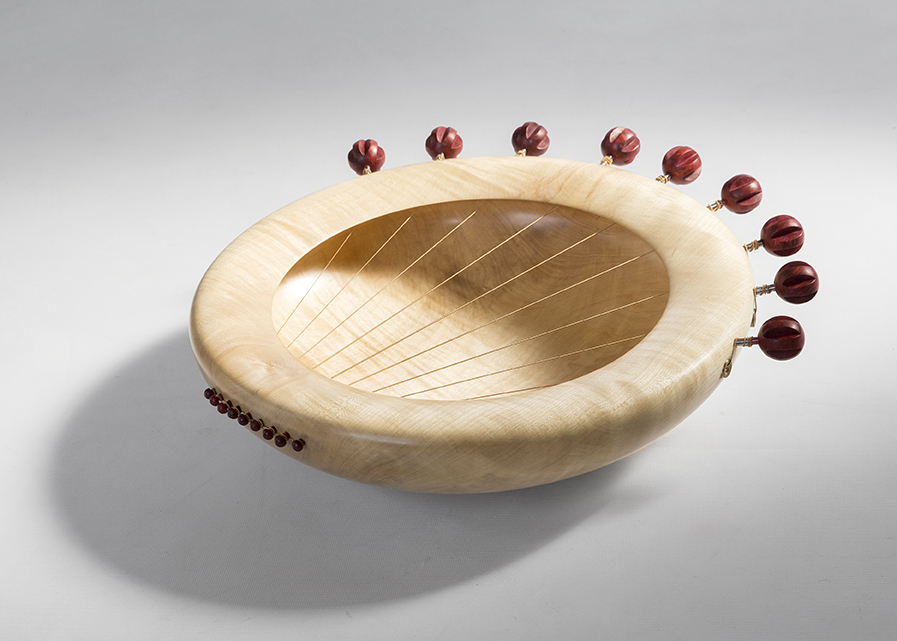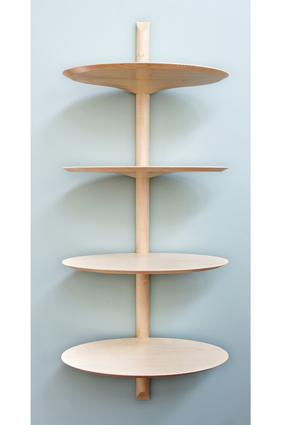Working in collaboration with Woodland Heritage this award looks to promote the use of local resources to produce pieces that have added meaning beyond their basic function.
It is an exciting prospect for many people to have a piece that has been conceived, designed and made locally by an artisan. Part of the reason for this is that one can speak to the designer-maker in person and understand their inspiration and the stories behind the piece. To be able to extend this understanding further with the origin and history of the timber, sometimes down to its precise location as a tree, will inevitably therefore serve to add to a client’s enthusiasm and emotional attachment to their purchase.
The use of local materials has obvious benefits for the designer-maker’s local economy and environment. The proper felling, processing and drying of wood are skilled trades that are important to preserve to ensure the continued effective management of the woodlands, forests and landscapes that we all enjoy. By using local materials in bespoke work, our exhibitors are ensuring that it is used beautifully, in an item that will be cherished and kept for generations.
The award is open to all exhibitors and judged by a panel during the show, with the criteria including design, species selection, use of timber, craftsmanship and provenance of the wood used. Points will be awarded to entrants who go out of their way to source timber locally and/or find out where their timber comes from.
2016 Award
Winner
.jpg)
Chris Wiseman with his ‘Oak Within’ Sideboard in Sycamore and Oak. The judges said:
“The remarkable quality of this piece displays an exceptional range of skills. An aesthetically imaginative design with immaculate craftsmanship. A craftsman for the future.”
Chris Wiseman was also one of the 2016 Winners of the Alan Peters (Student) Award for Excellence. We asked him for a little information about the piece:
“This was my second ever piece of furniture that I had designed and made myself. I wanted to learn the core of true furniture making but at the same time include some modern techniques. The smooth, clean lines and finger pull handles along with the soft white sycamore all give it a sleek contemporary look. As the front of the cabinet loosely resembles a tree, I wanted there to be a contrasting timber to highlight that feature. Oak was the obvious choice for me as it is a very traditional timber used in furniture making and also complements the sycamore well. The sideboard is mainly a solid frame-and-panel construction with certain areas created from man-made boards to prevent movement. I finely finished the piece in Danish oil and decided to keep the inside untreated so the feel and the smell is natural.”
Highly Commended

Robert Scott with his ‘Aeolian’ Console Table in Ash. Sculpted by hand and inspired by rock formations created by wind erosion.
“A clever sculptural piece with real impact. Its organic shapes have an enduring quality with strong fluid lines” (Judges Comment)
We asked Robert for a bit of background about the piece:
“Aeolian processes, pertain to wind activity in the study of geology and weather and specifically to the wind’s ability to shape the surface of the Earth (or other planets). Navajo Sandstone that I researched is located in southern Utah and northern Arizona. The sandstone is being actively eroded by sand-laden, south-westerly wind. The table took about 6 weeks to complete. I use an angle grinder with carving tool to create the majority of the shape. I also use chisels and rasps to refine the shape before sanding.”Special Mention

Paul Jaques Design with his ‘Walnut Poem’ Coffee Table 153 carved walnut units finished, on the exterior, with sealed Nitram charcoal with bronze elements.
‘If ever useless timber has been rescued to great effect, this is it. Huge effort has been made to maximise the beautiful English walnut grain, with numerous small carved units which combine to produce a truly inspirational piece.” (Judges Comment)
We spoke to Paul in some detail about this special table:
“2 years ago I was offered some walnut. I drove to Wiltshire to pick it up and found that it had already been logged and not left as usable lengths. I brought a load of 12” pieces home and left them to season for a year. I was confined by the size of the pieces and I have made a multi-unit structure which shows the fabulous qualities of the timber. Small bronze elements drip down into the centre to give a dynamic element to the piece. The exterior is deliberately “hacked” to simulate chain-saw brutality and coated with charcoal to represent the burning of logs.”
The poem that accompanies the table and some ‘in the making of’ photos can be found in the pieces feature:
http://www.celebrationofcraftsmanship.com/walnut_coffee_table.aspx
2015 Award
Winner

Matthew Burt‘s Bow – Fronted Chest Of Drawers
“Simply exquisite craftsmanship: Imaginative quartered ash drawer construction. The British ash is enhanced by careful selection of the olive colour on the carcase. The design is simple but entirely original.”
Highly Commended

Gareth Batowski Furniture‘s ‘Ely’ Drinks Cabinet
“A perfect solution to a challenging structural concept using multiple timber species: Glass and carbon fibre have given a well-lit interior which is beautifully crafted.”

William Self‘s ‘Quilted Perception’
‘A striking chair of heavily contrasting timbers. Surprisingly comfortable and perfectly finished.”
2014 Award Winners

After much debate, they adjudged Young & Norgate’s ‘Animate’ writing desk as their winner which has been produced using 4000 year old bog oak from the peat bogs of East Anglia. The judges were particularly impressed by the exquisite craftsmanship and decorative use of the grain pattern within the timber and also by the innovative exposed drawer slides which make the piece a delight to use.


David Watson’s ‘Stockinged Leg’ chair was also highly commended for its comfort, design concept and appealing combination of British Sycamore with Walnut. Also Commended was ‘Heart’ by Sounding Bowls which demonstrates superb turning skills to produce a romantic, elegant and tactile instrument that has a unique sound thanks to the English Sycamore which has been used to make it.
2013 Award Winners

In 2013 we had a very encouraging number of entries with some truly stunning pieces of design and craftsmanship. Our judges named Charles Thomson Fine Furniture as their winner for his desk top tambour made using English Walnut, sourced from a huge tree growing on a fruit farm in Kent. The tree was owned by a family friend whose grandfather had planted it 90 years ago. Charles dug out the huge tree, roots and all and had the root bowl milled into panels that he uses for special commissions such as this. It was the functionalityand movement of the piece along with the story and conservative use of timber that steered the Judges to select this piece as the 2013 winner.Two other entries were highly commended.
Eleanor Lakelin, who entered a range of wood turned forms and bowls, was highly commended for her ‘Ammonite’ Form that represented a shell or fossil. The timber which was sandblasted, bleached, turned on a lathe and hand carved, came from a misshaped lump of Horse Chesnut burr from a tree planted in 1710 on the Boughhton House Estate in Northamptonshire. Eleanor is keen to give some sense of the power and beauty of natural forms through her work and this ability to highlight the organic nature of her work was evident in the commended piece.

Cato Design‘s ‘Elevata’ Shelves in Sycamore were also singled out for their elegance and simplicity. The shelves were designed to display beautiful objects and were well received by the judges and visitors alike.